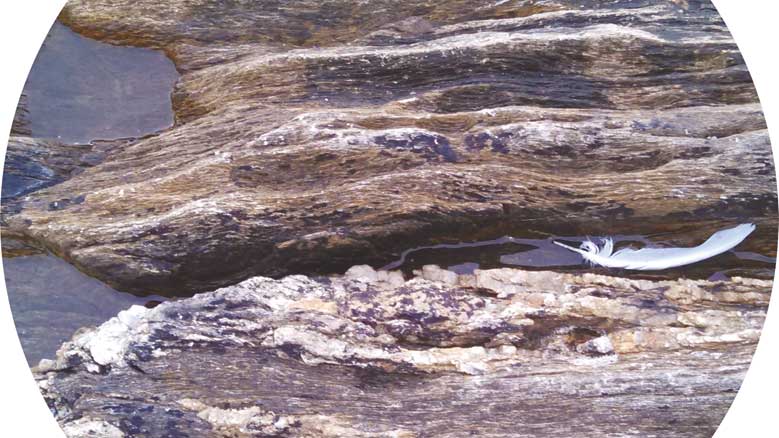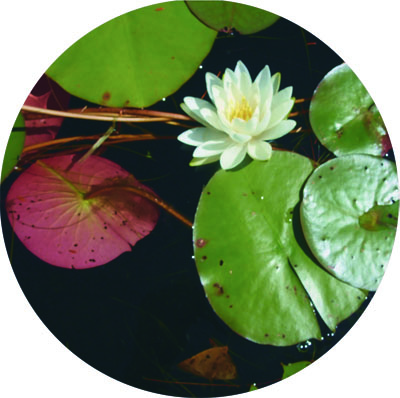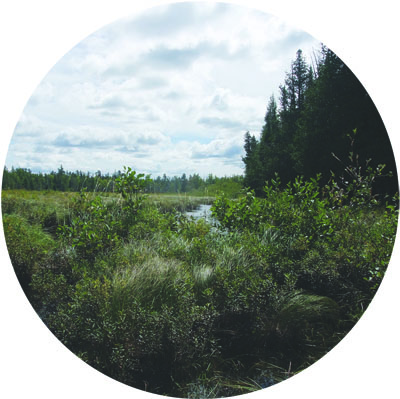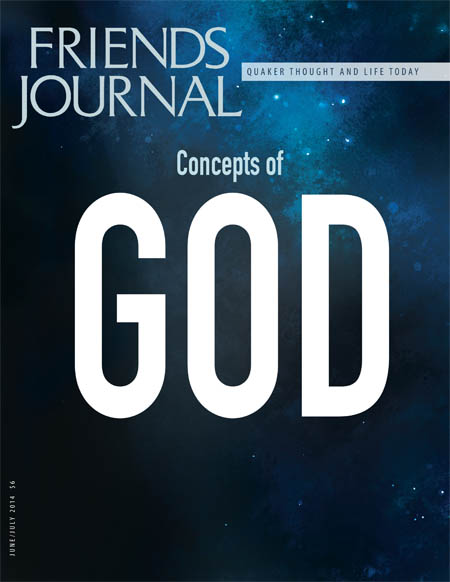For Healing the Earth

Since my retirement as general secretary of Friends General Conference (FGC) in 2011, I have been exploring new ways of imaging and understanding God (or the Spirit). My efforts start from an understanding that different people mean very different things when they use the word “God,” and that it is impossible to know or define God precisely, even for a small group of fellow believers. So we talk about God metaphorically, with images or models that make sense to us.
At the FGC Gathering in Colorado last summer, I led a workshop designed to explore some of these new images and models of God. This exploration feels important to me for three reasons. The first is personal. Traditional Christian images of God ceased speaking to my condition decades ago. For me, the word “God” does not mean something like a divine “super-person.” The way I use the word “God” is to denote a cosmic creative and animating force that is both immanent and transcendent. I often call this force “the Spirit.” I continue to have experiences of the Spirit that underlie my faith. I need metaphors and images for this Spirit, lest it be simply an intellectual abstraction. It’s helpful to have a framework for understanding these experiences, and for communicating with others about them.
The second reason stems from my love for our Religious Society of Friends. We Friends need images or models of God that work for us, in our present time, with our growing scientific understandings of the universe. Without images and language to express the power that can come through living in the Spirit, our meetings for worship tend to be little more than occasions for sharing and analyzing personal feelings and lamenting political and social ills. That path leads to the Secular Society of Friends.
The third reason I see this exploration as important has to do with the need for action in the context of preserving our planet. With the effects of climate change and related environmental challenges, we face the possibility of a catastrophe that could wreak unimaginable devastation on our earth, killing billions of people and destroying much of the current biosphere, probably ending human civilization in the process. To avoid this fatality, we need to make fundamental social, political, and economic changes. I do not believe we can make such dramatic changes without major cultural changes, particularly in how we understand and act on our relationship to the rest of the earth. For much of the history of humanity, religious faith and systems of belief have been at the core of this understanding, and hence a main determinant of human behavior. So discerning and communicating a new, earth- or creation-centered understanding of the Spirit or God that is consistent with this need for change is a critical part of any strategy for action.
Considering New Models of God
 I called my FGC workshop “The Burning Oneness Binding Everything.” This title, which I also used for my 1997 Pendle Hill pamphlet, comes from the last line of the opening poem in Kenneth E. Boulding’s small, but wonderful volume There Is a Spirit: The Nayler Sonnets. I will return to this poem at the end of the article. In my workshop, I sought to share some of my experiences of the Spirit, communicate my evolving understandings of these experiences, and learn from the experiences and insights of those participating in the workshop.
I called my FGC workshop “The Burning Oneness Binding Everything.” This title, which I also used for my 1997 Pendle Hill pamphlet, comes from the last line of the opening poem in Kenneth E. Boulding’s small, but wonderful volume There Is a Spirit: The Nayler Sonnets. I will return to this poem at the end of the article. In my workshop, I sought to share some of my experiences of the Spirit, communicate my evolving understandings of these experiences, and learn from the experiences and insights of those participating in the workshop.
In following with Christian theologian Sallie McFague, whose 1987 book Models of God: Theology for an Ecological, Nuclear Age challenges Christians’ usual speech about God as a monarch, I shared my understanding of God as a mystery that humans attempt to describe through metaphors or models. In Models of God, McFague argues that the old metaphor of God as Lord or King is no longer appropriate for our time. She describes three major flaws in this monarchical model: “God is distant from the world, relates only to the human world, and controls the world through domination and benevolence.” As she notes, this understanding of a God-king is no longer believable for many of us. A more serious consequence of this model, in which God created the earth and then gave man dominion over it, is that it has provided a problematic religious and cultural foundation responsible for the increasingly catastrophic exploitation of our earth which in turn has led to global warming and other aspects of our current ecological crisis.
So we are in need of creative new images or models of God (the Spirit) that will inspire and guide us to adapt a very different way of living on the earth. Brian Swimme, an evolutionary cosmologist professor at California Institute of Integral Studies, described this need beautifully and simply in his book The Hidden Heart of the Cosmos: Humanity and the New Story: “We need to put our energy into inventing new cultural forms for initiating ourselves into an ecstatic sense of involvement with the community of beings that is the very universe.”
The Body of God
 In recent years, I have been experimenting with an understanding of the earth—and all of creation—as the actual body of God, or the embodied Spirit. From this perspective, the physical earth becomes the aspect of God that we can see and experience most directly. I was first introduced to this idea in an intellectual sense by McFague, particularly in her 1993 book, The Body of God: An Ecological Theology.
In recent years, I have been experimenting with an understanding of the earth—and all of creation—as the actual body of God, or the embodied Spirit. From this perspective, the physical earth becomes the aspect of God that we can see and experience most directly. I was first introduced to this idea in an intellectual sense by McFague, particularly in her 1993 book, The Body of God: An Ecological Theology.
Many years before reading that book, however, I had already become familiar with this more tangible way of experiencing God. In 1965, I took an anthropology course taught by David McAllester at Wesleyan University. At the time, David was the clerk of Middletown (Conn.) Meeting, and I credit him for introducing me to Quakerism. I began attending meeting for worship and spending time with David and his family. He introduced me to a new way of experiencing beauty in general and the natural world in particular. On many walks together through the woods and meadows of the northeast, and in countless stories and conversations, David opened up a whole world of wonder and joy grounded in the natural world that has been feeding my soul for more than four decades. He passed away in 2006, but even today, I refer to David as my spiritual father.
In my Pendle Hill pamphlet, The Burning Oneness Binding Everything, I describe my earliest experience of this aspect of God:
During the winter of 1967, I had my first powerful experience of the Spirit through a special opening to beauty. I had been snowshoeing through the White Mountains of New Hampshire with three friends. We climbed Mount Garfield, traversed a long ridge, and dropped down into a narrow valley. We made camp at a place called Thirteen Falls, ten miles from the nearest road. The day had been gray, heavily clouded, but the weather was changing by evening. I left our small fire and walked alone through the dark to the stream which tumbled down a rocky face under ice and snow.
The air around me was calm. But high above the surrounding peaks, the wind tore at the clouds, pulling them to shreds, blowing them fiercely off to the east. Beyond the cloud remnants, the sky shone a deep blue-black. A full moon rose over the eastern ridge, backlighting the cloudshreds to a luminescent white, shining brilliantly on the snow about me. I stood a long time, drawn into the world I was seeing so deeply. Awe and comfort both overwhelmed me: awe at the incredible beauty of this creation, and comfort at the sense that I truly belong here, that I am one with this marvelous, Spirit-filled, beauty-throbbing creation.
My life has been full of such experiences in the wild, as well as other experiences of incredible beauty in music, art, people, and other parts of creation. The understanding of all these collective experiences as “the Spirit embodied” speaks to my condition. I see the creation, the entire universe, as the visible part of God, or God’s body. However, this definition should not be interpreted to suggest that what we experience of the earth and universe through our senses or our intellect is the sum total of God. In theological terms, this model is panentheistic, positing that the Divine (for me, a cosmic animating force) is in every part of the created universe, and that the Divine also somehow extends beyond the universe that is discoverable with our scientific tools. (This latter point distinguishes panentheism from pantheism, which holds that the Divine is synonymous with the created universe, full stop.) Nevertheless, the beauty and order of the universe do tell us important things about the creativity and principles at its core.
Therefore, this particular understanding of God is enhanced by our growing understanding of the creation and evolution of the universe, of the earth, of life, and of human beings. From the study of science, we have learned that the universe burst into existence in one incredible moment some 13.7 billion years ago. It took some time for atoms to form, and these were limited to the simplest ones: hydrogen and helium. It took a billion or so years for these atoms to coalesce and form stars and galaxies. In the nuclear fires of these stars, all the other elements were created. Around 4.6 billion years ago, gravitational forces created the sun and our solar system out of a gigantic molecular cloud. Earth subsequently began as a mass of molten material that slowly cooled, eventually creating land, water, and an atmosphere. In this crucible, life began then evolved into billions of life forms. What an incredible story! How could all this happen? What is the force, the energy, that gave rise to all life? If we call this cosmic animating force God, then we can understand the earth and all of creation as God’s body.
Worshiping in the Wild
 On the third day of my workshop at FGC, I led the entire group on a day-long trip into the Rocky Mountains in order to worship together in a beautiful corner of the wilderness. With help from some Internet research and several Quaker hikers I met online, I picked out a backcountry trail that traversed a high valley north of Estes Park. We hiked a short distance up the trail, waded a small stream, and settled ourselves in a grove of pine trees in the midst of a large meadow of grasses and flowers. We worshiped together, had lunch, and then went off individually to find separate beautiful spots where each of us could worship alone.
On the third day of my workshop at FGC, I led the entire group on a day-long trip into the Rocky Mountains in order to worship together in a beautiful corner of the wilderness. With help from some Internet research and several Quaker hikers I met online, I picked out a backcountry trail that traversed a high valley north of Estes Park. We hiked a short distance up the trail, waded a small stream, and settled ourselves in a grove of pine trees in the midst of a large meadow of grasses and flowers. We worshiped together, had lunch, and then went off individually to find separate beautiful spots where each of us could worship alone.
Most of the workshop participants found the hour-long solo worship to be a deeply meaningful experience. Many were nourished by the incredible beauty of the valley: the trees, flowers, and streams. Friends noticed details they usually missed: a woodpecker flying to and from a hole in the tree is discovered to be feeding baby birds, an ant carrying crumbs from our picnic lunch through the grass, the delicate beauty of blue and white mountain columbines.
During our preparation for this experience, I emphasized that each and every one of us is fully a part of this marvelous creation. Traditional Christian theology emphasizes a divide between humans (who are created in God’s image) and the rest of the world. In contrast, I believe we are each a part of God’s body experiencing other parts of God’s body. We humans are distinguished from other (most other?) life forms on earth by virtue of our capacity for conscious self-awareness. But this consciousness is just one of a myriad of incredible evolutionary outcomes in earth’s life forms. So when we experience the awesome beauty of some aspect of God’s body—whether it be on a mountaintop, in a concert hall, or sinking into the Milky Way in a crystal-clear night sky—we can feel a deep sense of unity with all that is.
This experience of unity with others, or with all of creation, is fundamental to the mystical experience. It also is fully consistent with a panentheistic understanding of the relationship between the Spirit and the universe. Meister Eckhart, a thirteenth-century theologian, philosopher, and mystic, wrote, “God created all things in such a way that they are not outside himself, as ignorant people falsely imagine. Rather, all creatures flow outward, but nonetheless remain within God.” Similarly, Mechtild of Magdeburg, another medieval mystic, described her vision of God: “The day of my spiritual awakening was the day I saw—and knew I saw—all things in God and God in all things.” Both are expressing an essential unity of all things, and placing that experience in their understandings of God.
The Burning Oneness Binding Everything
And this brings me back to Boulding’s poem “There Is a Spirit Which I Feel.” For me, this sonnet beautifully expresses the struggles I have had on my spiritual journey and the spiritual place that I now call home.
There Is a Spirit Which I Feel
Can I, imprisoned, body-bound, touch
The starry garment of the Oversoul,
Reach from my tiny part to the great Whole,
And spread my Little to the infinite Much,
When Truth forever slips from out my clutch,
And what I take indeed, I do but dole
In cupfuls from a rimless ocean-bowl
That holds a million million million such?
And Yet, some Thing that moves among the stars,
And holds the cosmos in a web of law,
Moves too in me: a hunger, a quick thaw
Of soul that melts the ancient bars,
As I, a member of creation, sing
The burning oneness binding everything.
As with any good sonnet, the first eight lines describe one condition—in this case, despair at being imprisoned in a physical body, cut off from the transcendent “Oversoul,” and hopelessly limited to the tiniest sips of truth from an unimaginable ocean of Truth. In the final six lines, however, comes a turning, beginning with a glimmer of hope, of faith, as Nayler, the subject of the sonnet, understands that “the great Whole,” “the infinite Much,” moves also in him. That movement grows within him, melting “the ancient bars” that have separated him from that cosmic Spirit. In the final two lines, he celebrates, with exceeding joy, his unity with all that is—“the burning oneness binding everything.”
Friends have asked me, “Why do you think Boulding refers to this as a burning oneness? Why not something less destructive than this fiery image?” I believe his choice of words is significant. I believe that Friend Boulding did not want to suggest that this unity with all that is, including the creative force in and beyond the universe, is a simple experience of sweetness and light. It is much more dramatic, more transformative, than that. To me, he suggests that we need to destroy our old images of God and forge new understandings in the creative fires of mystical experience. These new understandings will include a new and powerful sense of unity with everyone and everything on earth and in the entire universe.



Thank you Bruce for language that speaks to me. I am still looking for a way for living in a religious or sacred space with people who speak my language, more or less. My life experience has not been one of sweetness and light and I have run out of churches, literally and figuratively. Your use of the word “burning” is significant and apt. I am reminded of forest fires that destroy everything in their path and yet, are necessary for new life. My imagination attempts to hold things together, light/ dark, destruction/ creation.
A humming bird is spinning on the point of his beak, feeding on bright orange and red lantana blossom on my balcony. I hold my breath. And now he’s gone. Thunder crashes, and the rain pours down. Now, there is light in the sky.
Perhaps I will try and find a group of Friends in the Vancouver area. I am 83 now and use a mobility scooter so getting around is a challenge. I have never felt so body bound. I need help sometimes in keeping up my spirit. Thank you.
God bless,
meri
I wish to thank you, Friend Bruce Birchard. This was an interesting in presenting alternate cosmic views in reference to diverse new ways of defining God or ‘the force’ of Love. You also have a good way of referring to all, especially life, created in a common energy or cosmic spirit.
It is conscious self-awareness in the myriad of incredible evolutionary outcomes which hits hard in the world we live. When reaching out through the spirit of life on earth, now courtesy of our technological advances, we are finding a global consciousness.
Although evolution has developed many differing cultures, in each individual life, a light, piece of God, or whatever term preferred, exists. This provides a solid reason for the existence of Holism or the total is greater than the sum of the parts. It also presents a base for determining parts correlating in all cultures.
When moving to a culture, world, global, or cosmic level, conscious self-awareness by an individual, becomes a mere part of Universalism. Knowing oneself is important in fitting into those larger viewpoints, especially cosmic energy.
May God be with you.